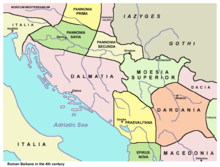
Pannonia was a province of the Roman Empire bounded on the north and east by the Danube, coterminous westward with Noricum and upper Italy, and southward with Dalmatia and upper Moesia. Pannonia was located in the territory that is now western Hungary, western Slovakia, eastern Austria, northern Croatia, north-western Serbia, northern Slovenia, and northern Bosnia and Herzegovina.

Magnus Aurelius Cassiodorus Senator, commonly known as Cassiodorus, was a Christian, Roman statesman, renowned scholar of antiquity, and writer serving in the administration of Theodoric the Great, king of the Ostrogoths. Senator was part of his surname, not his rank. He also founded a monastery, Vivarium, where he worked extensively the last three decades of his life.

Sirmium was a city in the Roman province of Pannonia, located on the Sava river, on the site of modern Sremska Mitrovica in the Vojvodina autonomous province of Serbia. First mentioned in the 4th century BC and originally inhabited by Illyrians and Celts, it was conquered by the Romans in the 1st century BC and subsequently became the capital of the Roman province of Pannonia Inferior. In 294 AD, Sirmium was proclaimed one of four capitals of the Roman Empire. It was also the capital of the Praetorian prefecture of Illyricum and of Pannonia Secunda. The site is protected as an archaeological Site of Exceptional Importance. The modern region of Syrmia was named after the city.
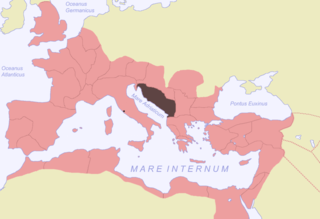
Illyricum was a Roman province that existed from 27 BC to sometime during the reign of Vespasian. The province comprised Illyria/Dalmatia in the south and Pannonia in the north. Illyria included the area along the east coast of the Adriatic Sea and its inland mountains, eventually being named Dalmatia. Pannonia included the northern plains that now are a part of Serbia, Croatia and Hungary. The area roughly corresponded to part or all of the territories of today's Albania, Kosovo, Montenegro, Serbia, Bosnia and Herzegovina, Croatia, and Slovenia.

The praetorian prefecture of Illyricum was one of four praetorian prefectures into which the Late Roman Empire was divided.
The praetorian prefecture was the largest administrative division of the late Roman Empire, above the mid-level dioceses and the low-level provinces. Praetorian prefectures originated in the reign of Constantine I, reaching their more or less final form in the last third of the 4th century and surviving until the 7th century, when the reforms of Heraclius diminished the prefecture's power, and the Muslim conquests forced the Eastern Roman Empire to adopt the new theme system. Elements of the prefecture's administrative apparatus, however, are documented to have survived in the Byzantine Empire until the first half of the 9th century.
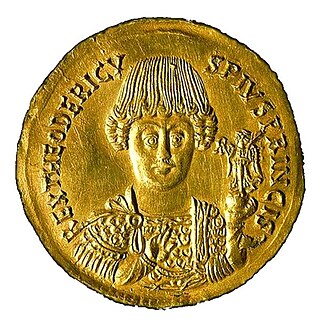
The Ostrogothic Kingdom, officially the Kingdom of Italy, existed under the control of the Germanic Ostrogoths in Italy and neighbouring areas from 493 to 553.
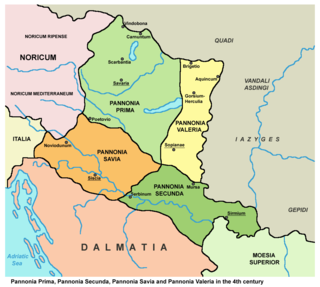
The Pannonia Valeria or simply Valeria, also known as Pannonia Ripensis, was one of the provinces of the Roman Empire. It was formed in the year 296, during the reign of emperor Diocletian, in a division of Pannonia Inferior. The capital of the province was Sopianae. Pannonia Valeria included parts of present-day Hungary and Croatia.

Pannonia Prima was an ancient Roman province. It was formed in the year 296, during the reign of Emperor Diocletian. Previously, it was a part of the province of Pannonia Superior, which, along with Pannonia Inferior, was gradually divided into four administrative units: Pannonia Prima, Pannonia Secunda, Valeria, and Savia. This transition was completed by the time of Constantine. According to the Notitia Dignitatum, Pannonia Prima was governed by a Praeses.

Pannonia Secunda was one of the provinces of the Roman Empire. It was formed in the year 296, during the reign of emperor Diocletian. The capital of the province was Sirmium. Pannonia Secunda included parts of present-day Serbia, Croatia, and Bosnia and Herzegovina.

The Diocese of Pannonia, from 395 known as the Diocese of Illyricum, was a diocese of the Late Roman Empire. The seat of the vicarius was Sirmium.

The Diocese of Macedonia was a diocese of the later Roman Empire, forming part of the praetorian prefecture of Illyricum. Its administrative centre was Thessalonica.

The Diocese of Dacia was a diocese of the later Roman Empire, in the area of modern western Bulgaria, central Serbia, Montenegro, Kosovo, northern Albania and northern North Macedonia. It was subordinate to the Praetorian prefecture of Illyricum. Its capital was at Serdica.

The praetorian prefecture of Italy was one of four praetorian prefectures into which the Late Roman Empire was divided. It comprised the Italian peninsula, the Western Balkans, the Danubian provinces and parts of North Africa. The Prefecture's seat moved from Rome to Milan and finally, Ravenna.
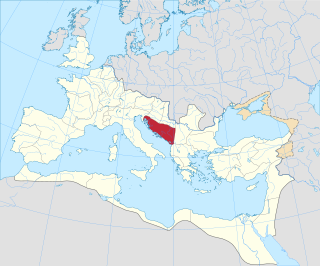
Dalmatia was a Roman province. Its name is derived from the name of an Illyrian tribe called the Dalmatae, which lived in the central area of the eastern coast of the Adriatic Sea. It encompassed the northern part of present-day Albania, much of Croatia, Bosnia and Herzegovina, Montenegro, Kosovo and Serbia, thus covering an area significantly larger than the current Croatian region of Dalmatia. Originally this region was called Illyria or Illyricum.

Praevalitana was a Late Roman province that existed between c. 284 and c. 600. It included parts of present-day Montenegro, Albania, and part of present-day Kosovo. Its capital city was Doclea, later Scodra.

Early Slavs settled in the eastern and southern parts of the former Roman province of Pannonia. The term Lower Pannonia was used to designate those areas of the Pannonian plain that lie to the east and south of the river Rába, with the division into Upper and Lower inherited from the Roman terminology.

Posavina is a geographical region that stretches along the Sava river, encompassing only the inner areas of the Sava river basin, that are adjacent or near to the Sava river itself, namely catch region spanning from the Julian Alps in the northwest to the confluence with the Danube in the southeast. It passes through several countries of former Yugoslavia, namely Slovenia, Croatia, Bosnia and Herzegovina and Serbia. In Slovene, the term Posavina is not used to describe the parts of Slovenia that lie by the Sava river. Instead, the terms Posavje, Zasavje and Zgornjesavska dolina are used.
The Battle of Bolia, took place in 468 between the Ostrogoths and a coalition of Germanic tribes in the Roman province of Pannonia. It was fought on the south side of the Danube near its confluence with the river Bolia, in present-day Hungary. The Ostrogoths won, achieving supremacy in Pannonia, but soon migrated south towards richer lands.
